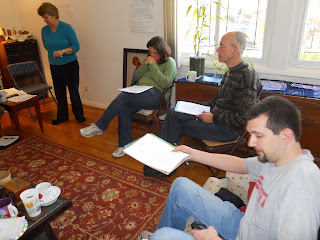http://www.baltimoresun.com/news/maryland/baltimore-city/bs-md-ci-rebuilding-playground-hill-20100921,0,666502.storyHere is the follow up to the September 14, 2010 post on Dan Rodrick's column about one church's effort to reclaim a small area in East Baltimore. Carolyn Pitt's quote at the end of the article points out an uncomfortable fact that we can identify with. The struggle to reclaim her neighborhood will require coordinated and sustained effort. Left on its own, the neighborhood will quickly return to it old self much the same way an untended garden quickly becomes choked by encroaching weeds which thrive on neglect. It will also require the belief that individuals, banding together, are able to make a difference. Mixed in there is a strong conviction that an improved neighborhood is in one's interest. Christians will have to be obedient to the biblical injunction to bring about the kingdom of God in the here and now. I will leave it to those of you who are more theological minded to assay the soundness of this theology.
Community volunteers clean up playground near homicide site
Councilman says effort is follow-up to vigils after high-profile deaths of church worker, Hopkins researcher By Jessica Anderson, The Baltimore Sun
10:08 p.m. EDT, September 21, 2010
The weeds behind the vacant lot next to Carolyn Pitt's Aiken Street home had reached her clothesline, but on Tuesday, volunteers mowed the plants down, picked up trash and painted the nearby playground to ignite efforts to revitalize the neighborhood.
"Beer bottle, glass, needles — you name it" can be found in the small patch of pavement with a missing basketball hoop, Pitt, 54, said from her tidy front steps. "It's wonderful they are giving kids a chance to play over there," she said as she sat with two of her grandchildren, who she will not allow to play in the area because of the constant drug traffic.
About 50 volunteers with the nearby Ark Church and the Police Department's Eastern District cleared more than 20 tall bags of debris from the playground. The cleanup was part of "Operation Good Faith," an East Baltimore effort that calls on religious community members to look after a four-block radius around their place of worship.
Customized. Optimized. Pocket sized. Buy the new Baltimore Sun iPhone app.
Less than two months ago, Pitt's neighbor — the caretaker of the Ark Church — Milton Hill was found slumped against a fence in a pool of blood behind his home next to the church. Police believe he was shot for his green scooter. Five days earlier, Johns Hopkins researcher Stephen Pitcairn was stabbed less than a mile away. The two crimes captured the city's attention and inspired two mournful vigils.
"This is a follow-up to the vigils. We won't just pray but move into action," said Councilman Carl Stokes, whose district includes both homicide sites and who attended the cleanup.
He said the city, with help from the Charles Village Civic Association, is hoping to place new playground equipment there in the next two months, as well as replace the lights where the wires were torn out. Members of the Ark Church will maintain the area.
Stokes said the cleanup is not only an effort to clear debris and paint, but "symbolic" that "we're saying no more to drug dealing."
The paved area on the corner of East Lafayette Avenue and Aiken Street is considered "an open-air drug market," said Eastern District Commander Maj. Melvin Russell. The district is committing a strong police presence to the area, and if drug dealers return, "we'll deal with them," he said.
"We didn't do this for nothing," he said of the cleanup. Russell himself helped, hopping on a shovel to dig out the strip of weeds and grass between the playground and the alley.
He said no arrests have been made in Hill's death, but that "we're getting close. We've got good leads."
Two people have been charged in Pitcairn's death.
The Eastern District has been one of the most violent, leading the city in the number of homicides. While last year it saw major decreases, the Eastern now leads the department with 32 homicides.
Russell said the district has seen a 15 percent decline in homicides so far this year, but he said it takes the community "buying into the vision that we can make this happen." He said he tries to encourage his officers to work with residents, otherwise, "as long as we have that great disconnect, nothing is going to change."
While a set of rusted monkey bars and two worn wooden jungle gyms remained, a fresh coat of green, yellow and orange paint was left to dry on a playground wall.
"They are doing a great job, but we don't know how long it's going to last," Pitt said.
Sylvester Toles, a member of the Ark Church, admitted he wasn't excited about the cleanup at first, after a long day at a moving company. But the 54-year-old said "the preacher wanted us to do it for the kids, to make it presentable for the kids. Somebody's got to show that somebody cares," he said.
As he worked up a sweat, he said, "I feel like I've accomplished something.























































